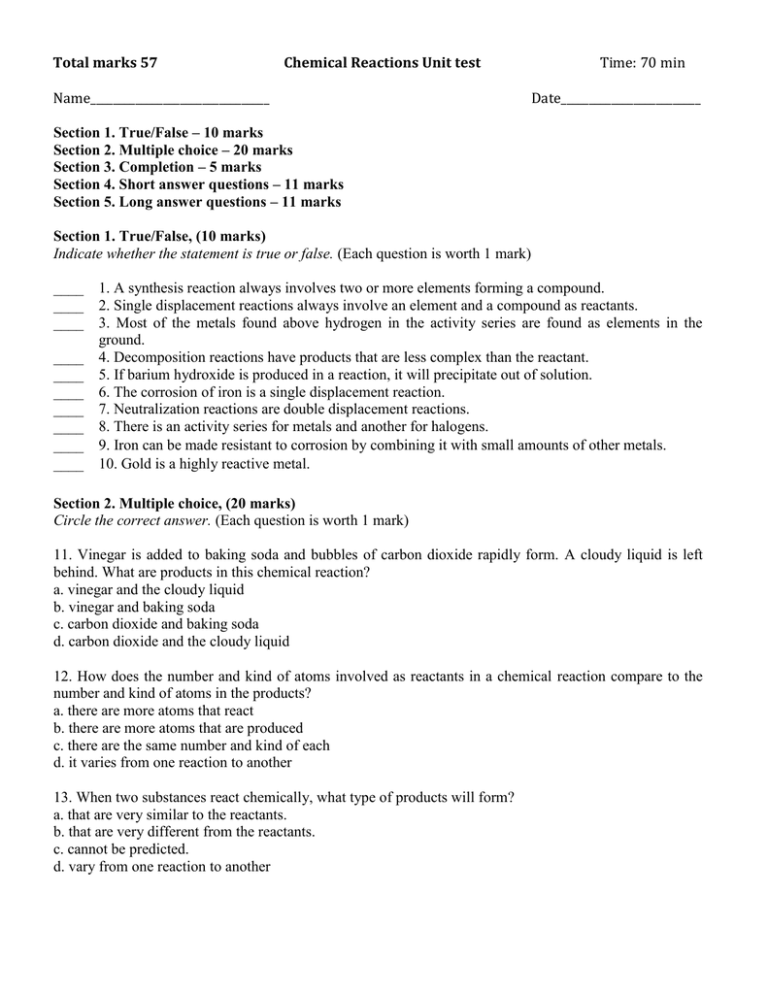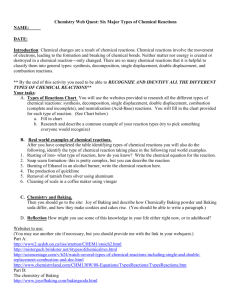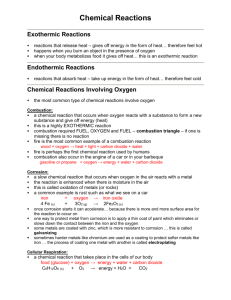Teacher Version_Unit Test_Chemical Reactions - OISE
advertisement

Total marks 57 Chemical Reactions Unit test Name________________________________ Time: 70 min Date_________________________ Section 1. True/False – 10 marks Section 2. Multiple choice – 20 marks Section 3. Completion – 5 marks Section 4. Short answer questions – 11 marks Section 5. Long answer questions – 11 marks Section 1. True/False, (10 marks) Indicate whether the statement is true or false. (Each question is worth 1 mark) ____ ____ ____ ____ ____ ____ ____ ____ ____ ____ 1. A synthesis reaction always involves two or more elements forming a compound. 2. Single displacement reactions always involve an element and a compound as reactants. 3. Most of the metals found above hydrogen in the activity series are found as elements in the ground. 4. Decomposition reactions have products that are less complex than the reactant. 5. If barium hydroxide is produced in a reaction, it will precipitate out of solution. 6. The corrosion of iron is a single displacement reaction. 7. Neutralization reactions are double displacement reactions. 8. There is an activity series for metals and another for halogens. 9. Iron can be made resistant to corrosion by combining it with small amounts of other metals. 10. Gold is a highly reactive metal. Section 2. Multiple choice, (20 marks) Circle the correct answer. (Each question is worth 1 mark) 11. Vinegar is added to baking soda and bubbles of carbon dioxide rapidly form. A cloudy liquid is left behind. What are products in this chemical reaction? a. vinegar and the cloudy liquid b. vinegar and baking soda c. carbon dioxide and baking soda d. carbon dioxide and the cloudy liquid 12. How does the number and kind of atoms involved as reactants in a chemical reaction compare to the number and kind of atoms in the products? a. there are more atoms that react b. there are more atoms that are produced c. there are the same number and kind of each d. it varies from one reaction to another 13. When two substances react chemically, what type of products will form? a. that are very similar to the reactants. b. that are very different from the reactants. c. cannot be predicted. d. vary from one reaction to another 14. How do you know when a chemical reaction has occurred? a. new substances have formed, it would be hard to reverse b. an explosion, gasses and light are given off c. the substance changes size, shape, texture and mass d. the mass of the reactants is changed into energy that is given off Use this information to answer the next two questions: Students measure 2.0 g of baking soda and 5.0 g of vinegar. They mix them together in a beaker and watch as bubbles form. The mass of the resulting liquid is 6.7 g. 15. Based on the Law of Conservation of Mass, what should the mass of the products be? a. 5.0 g b. 6.7 g c. 7.0 g d. 10.0 g 16. How should students redesign this experiment for better accuracy? a. use more baking soda and less vinegar b. be more precise in the use of the triple-beam balance c. use different substances so that the reaction is slower d. trap the escaping gasses 17. Baking soda can be used to neutralize some battery acid that has leaked or spilled. This reaction would be classified as a a. synthesis reaction b. decomposition reaction c. combustion reaction d. double displacement reaction 18. When baking soda is heated, sodium carbonate, water, and carbon dioxide gas are formed. This reaction can be classified as a. synthesis reaction b. combustion reaction c. decomposition reaction d. double displacement reaction 19. Which of the following combinations would result in the formation of a precipitate? a. acetic acid and potassium hydroxide solutions b. magnesium nitrate and sodium sulfide solutions c. sulfuric acid and barium hydroxide solutions d. sodium sulfate and copper(II) chloride solutions Use this equation to answer the following questions: Lead nitrate + Sodium Iodide Sodium Nitrate + Lead Iodide (both dissolved in water (dissolved in water) (bright yellow solid) forming clear solutions) 20. What type of reaction is represented in this equation? a. synthesis b. decomposition c. single displacement d. double displacement 21. Which of the following statements are true concerning chemical equations? I. Coefficients can be fractions. II. Subscripts can be fractions. III. Coefficients represent the relative masses of the reactants and/or products. IV. Changing the subscripts to balance an equation can only be done once. V. Atoms are conserved when balancing chemical equations. a. I, III, and V b. I, II, III, IV, and V c. III d. I and V Use this following equation to answer the following question: 6CO2 + 6H2O C6H12O6 + 6O2 22. If four carbon atoms undergo a chemical reaction with oxygen to form CO2 molecules, how many carbon atoms will be found in the product? a. one b. two c. three d. four 23. Which reaction will NOT occur? a. Zn + NiCl2 Ni + ZnCl2 b. I2 + 2KF F2 + 2KI c . Cu + 2AgNO3 Cu(NO3)2 + 2Ag d. Sn + CuCl2 Cu + SnCl2 24. Which reaction WILL occur? a. Cu(NO3)2 + H2S CuS + NO2 b. Br2 + CaCl2 Cl2 + CaBr2 c. 2LiOH + H2 2Li + 2H2O d. Sn + CuSO4 SnSO4 + Cu 25. All the following are clues that a chemical reaction has taken place except a. a color change b. a solid forms c. the reactant is smaller d. a flame occurs 26. Hydrogen can be used as an alternative fuel for automobiles. Classify the following chemical reaction: 2H2(g) + O2(g) 2H2O(g) a. combustion reaction b. decomposition reaction c. single displacement d. double displacement 27. Which of the following always indicates that a chemical reaction has taken place? a. production of a gas b. absorption of heat c. change in color d. appearance of a new substance 28. Classify the following reaction: H2O + SO3 H2SO4 a. combustion reaction b. synthesis reaction c. decomposition reaction d. double displacement reaction 29. Classify the following reaction: Cl2 + ZnI2 ZnCl2 + I2 a. combustion reaction b. synthesis reaction c. decomposition reaction d. single displacement reaction 30. Which metal could be used to leach copper, Cu, out of copper(II) sulfate, CuSO4? a. silver, Ag b. gold, Au c. iron, Fe d. lead, Pb Section 3. Completion (5 marks) Complete each statement. (Each question is worth 1 mark) 31. A listing of metals from most reactive to least reactive is called the ____________________. 32. ____________________ is a light metal that is relatively expensive to mine and refine. 33. The product of reaction of a metal oxide with non-metal oxide is ____________________. 34. A(n) _________________________ reaction is one in which aqueous ionic compounds rearrange cations and anions, resulting in the formation of new compounds. 35. ___________oxides have acidic character, and _____________oxides have basic character. (1 mark for both correct answers, ½ for one correct answer) Section 4. Short answer questions (11 marks) 36. Complete and balance following equations: a) _Ag2O d) _AgNO3+ _Cu b) _FeO + _SO2 e) _AlBr3 + _K2SO4 c) _K + _AlCl3 f) _Fe + _O2 (1/2 mark for each of the equations) 37. Write a balanced chemical equation to represent the following: a) Reaction of barium oxide with water (1 mark) b) Reaction of carbon dioxide with water, (1 mark) a) b) 38. Explain how we get metallic iron from an ore that is an oxide of the iron. Write down the equation for the chemical reaction. (1 mark for explanation and 1 mark for the chemical equation) 39. What gas is produced during the complete combustion of fossil fuels? (1 mark) 40. What is the difference between complete and incomplete combustion in terms of the amount of oxygen? (1mark) 41. A yellow flame is produced from glowing carbon or soot particles. What type of combustion is this? (1 mark) 42. A blue flame is produced by what type of combustion? (1 mark) Section 5. Long answer questions (11 marks) 43. Imagine you live in a poor community that has discovered gold deposits in its land. To recover gold from rock, the ore is ground and mixed with lime. This mixture is then reacted with cyanide. The gold is then absorbed by carbon. A gold mine can do wonders for the local community, but the risk of a cyanide spill has some citizens up in arms. Decide if you think a gold mine and refinery should be constructed and support your position. (3 marks for listing either 3 or more pros or cons, 2 marks for listing 2 pros or cons, 1 marks for listing 1 pro or con, and 1 mark for final statement on whether gold mine and refinery should be constructed) 44. Corrosion is a major problem because our society makes extensive use of iron products. However, for some metals such as aluminum, corrosion is not a problem. Why don't we just use aluminum instead of iron and its alloys? Answer from at least two perspectives. (2 marks for listing the two different perspectives, 1 mark for listing one perspective and 2 marks for explaining the two perspectives, 1 mark for explaining one perspective) 45. "Carbon dioxide, water, nitrogen, and oxygen are harmless. If we simply put a catalytic converter in each car, this should solve our car pollution problem." Do you agree with this statement? State reasons for your answer and explain what a catalytic converter does. (2 marks for stating two or more reasons, 1 mark for stating one reason and 1 mark for explaining why you agree/disagree) Suggested Answers Section 1. True/False 1. F 2. T 3. F 4. T 5. F 6. T 7. T 8. T 9. T 10. F Section 2. Multiple choice 11. D 12. C 13. D 14. A 15. C 16. D 17. D 18. C 19. C 20. D 21. D 22. D 23. B 24. D 25. C 26. A 27. D 28. B 29. D 30. C Section 3. Completion 31. activity series 32. aluminum 33. salt 34. double displacement 35. Metal oxides, non-metal oxides Section 4. Short answer questions 36. a) Ag2O Ag+O2 b) 2FeO + 2SO2 2FeS + 3O2 c) K + AlCl3 Al + KCl3 d) AgNO3+Cu Cu(NO3)2+Ag e) AlBr3+K2SO4 KBr+Al2(SO4)3 f) 4Fe + 3O2 2Fe2O3 37. a) BaO (s) + H2O(l) ---> Ba 2+(aq) + 2 OH - (aq) b) CO2 (g) + H2O(l) ---> H2CO3 (aq) 38. Iron ore is ground to a powder and combined with coal (carbon) and heated until the mixture ignites. Liquid iron will settle to the bottom of the mixture. CO2 is given off. Impurities (slag) in the ore float to the top of the mixture. The basic equation is: 2Fe2O3(s) + 3C(s) -> 4Fe(l) + 3CO2(g). 39. carbon dioxide gas 40. Complete combustion needs the most oxygen. Insufficient oxygen produces incomplete combustion. 41. Incomplete combustion 42. Complete combustion Section 5. Long answer questions 43. Pros -Apply modern methods to contain environmental damage. -Community can force mining company to repair land when the project is complete. -Community can force mining company to remove contaminants. -Jobs will be generated. -There will be more money going into the local economy. Cons -Cyanide is extremely toxic. -Open-pit mines are an eyesore. -Open-pit mines cause extreme damage to the local environment. -Community may not have power to enforce environmental rules. 44. One important perspective is economics. The production of aluminum metal is much more expensive than iron. Iron ore is readily available in Canada, whereas aluminum ore (bauxite) must be imported from other countries. The technological process of smelting and refining iron is less expensive than the electrolytic production of aluminum. From a technological perspective, iron production is also simpler and the product is technologically more useful than aluminum. Iron is more versatile and has better mechanical properties for many applications. Another perspective is political. By solely using aluminum, we would be eliminating many jobs in the ironproduction industry. 45. -Nitrogen monoxide is produced by gasoline engine. -Platinum/palladium catalyst encourages decomposition of nitrogen monoxide to nitrogen and oxygen. -Carbon dioxide and water produced by combustion are greenhouse gases. They are not harmless in large amounts. 45.







